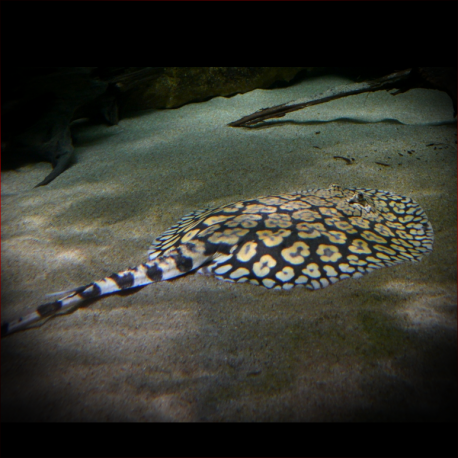More info
Datasheet
| Minimum Tank Size | 1700 litres / 449.09 US gallons |
| Maximum Size | 61.0cm / 24.02inches |
| Temperature | 20°C / 68.00°F - 29°C / 84.20°F |
| Hardness | 1-12ºdH |
| pH | 6.0-7.5 |
General Description
Potamotrygon Schroederi, commonly known as Flower Ray, is a highly sought-after member of the Potamotrygonidae family. This species is revered for its attractive appearance and is often scarce in the aquarium trade due to export restrictions in Brazil. Native to parts of Brazil and Venezuela, these rays are part of the Elasmobranchii class and boast a unique breeding strategy of matrotrophic viviparity. With a maximum size of 61.0 cm, these rays require a minimum tank size of 1700 litres for optimal care.
Aquarium Setup
When setting up an aquarium for P. schroederi, it is preferred to maintain warmer waters. Decor is not essential, but adding large chunks of bogwood, beech branches, or smooth rocks can enhance the environment. Open swimming space is crucial, along with dim lighting. Filtration is vital, necessitating a large and efficient biological filter or a sump-type arrangement. Weekly water changes of around 50% are recommended to maintain water quality.
Behaviour
Rays are top predators in their natural ecosystems and may not thrive when housed with aggressive tankmates. They exhibit a preference for peaceful companions, ideally occupying the upper parts of the tank. Rays can become tame, recognizing their owners and even begging for food. Handling rays requires caution due to their venomous sting, which is primarily used for defense. Exercise care during feeding and maintenance to prevent injuries to both the rays and the keeper.
Feeding and Diet
In the wild, rays primarily feed on fish and aquatic invertebrates, requiring a high metabolic rate and regular feeding. A meaty diet is preferable, with options like live or frozen bloodworms, mussels, prawns, and earthworms. Avoid feeding rays mammal meat or feeder fish, as it can lead to health issues. Newly imported rays may be reluctant to eat, requiring live foods initially before transitioning to dead alternatives.
Reproduction & Dimorphism
P. schroederi follows a breeding strategy known as matrotrophic viviparity, giving birth to live and fully-formed pups. Males and females can be easily distinguished, with males possessing claspers on their pelvic fins for mating purposes. Successful breeding in captivity requires careful mate selection, with gestation lasting between 1-8 months. Pregnant females should be well-fed, and pups should be provided with high-quality live and frozen foods after birth.
Habitat and Distribution
These rays inhabit various biotopes in South America, including sand banks, major river shallows, and slow-moving tributaries with mud or sand substrates. They also venture into flooded forest areas during the wet season and can be found in terrestrial lakes and ponds post-flooding. P. schroederi is native to parts of Brazil and Venezuela, with collections reported in the Rio Orinoco and Amazon basins.

